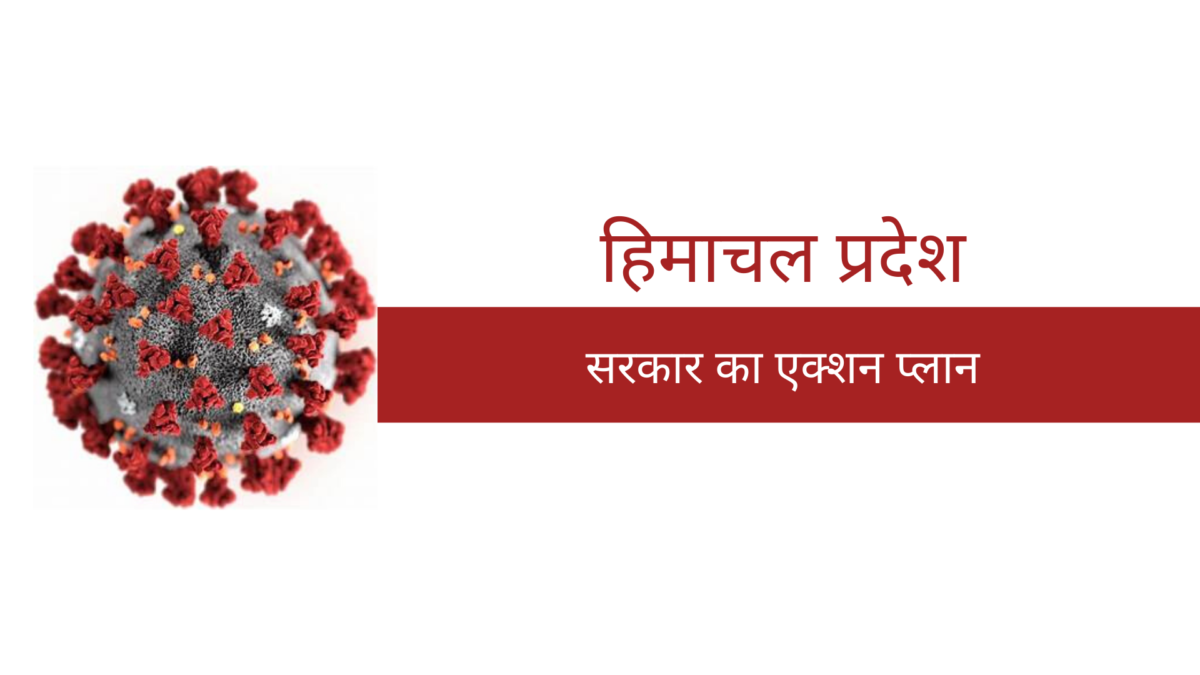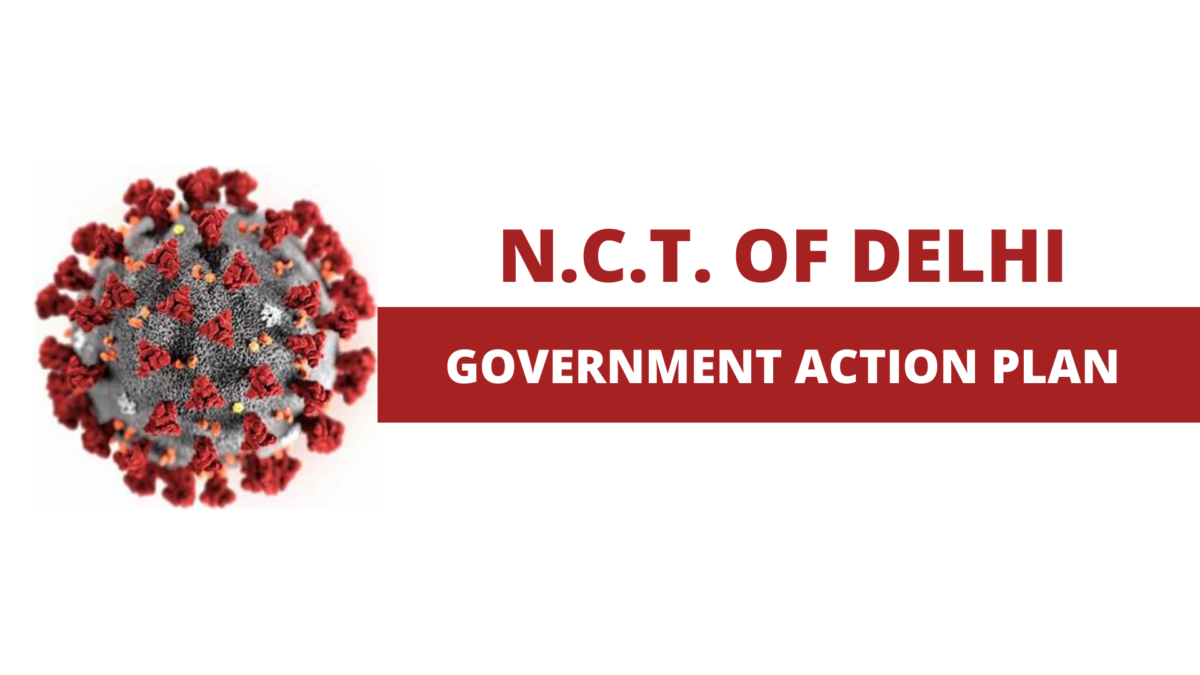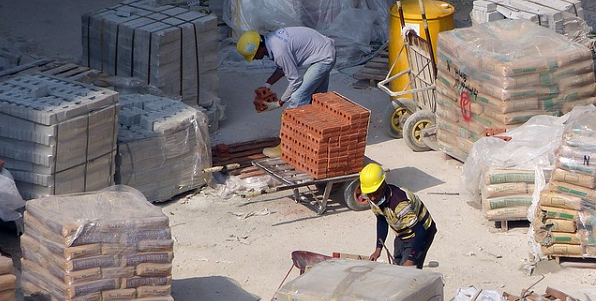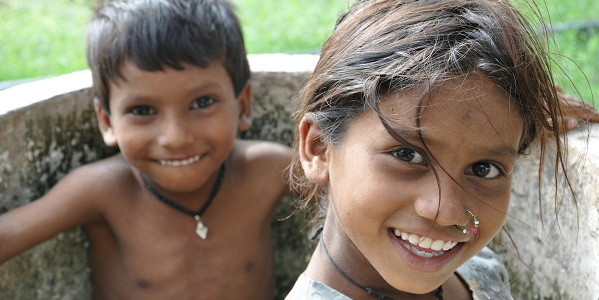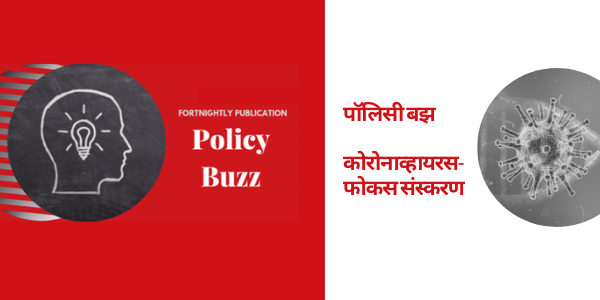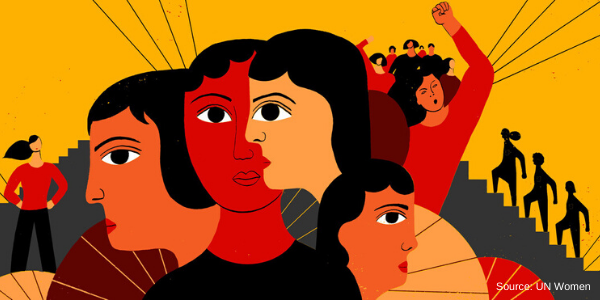यह ब्लॉग हम और हमारी सरकार पर पहले प्रकाशित किया गया था
Archives: Blog
Delhi’s COVID-19 Response
The Government of N.C.T of Delhi announced lockdown in the national capital on 23 March 2020, a day before the countrywide declaration by the Government of India. Below you will find a curated list of government decisions critical to the fight against the Coronavirus pandemic. *This blog was last updated on 7 April 2020.
Policy Buzz: Coronavirus-focus Second Edition
Keep up-to-date with all that is happening in welfare policy with this curated selection of news, published every fortnight. The current edition focusses on the Coronavirus pandemic in India, and the government’s efforts to stem its increase.
Policy News
- The Prime Minister has constituted eleven empowered groups as quick response teams to tackle the ongoing Coronavirus outbreak. These groups have been set up under the Disaster Management Act, and will be headed by secretaries. They will be in charge of medical emergency management, isolation and quarantine facilities, among other things.
- The government has chalked up a cluster containment strategy to contain the spread of Coronavirus within a geographical region.
- Finance Minister Nirmala Sitharaman has announced a package of Rs 1.7 lakh crore to protect healthcare workers and vulnerable sections.
- The Ministry of Finance has released ₹17,287 crore to states as the Union share for the State Disaster Response Mitigation Fund (SDRMF). This includes ₹6,195 crore ‘revenue deficit grant’ as per the 15th Finance Commission’s recommendations.
- Rs 5,125 crore has been transferred to farmers under the PM KIsan SAmman Nidhi scheme since the 1.7 lakh crore package was announced. This is the April-July instalment which has been released earlier than scheduled. Download our latest brief to know about the scheme.
- COVID-19 testing and treatment is now covered under the Ayushman Bharat–Pradhan Mantri Jan Arogya Yojana health insurance scheme. Download our latest brief to know who can benefit.
- A public charitable trust – Prime Minister’s Citizen Assistance and Relief in Emergency Situations Fund (PM CARES Fund) – has been created by the government. Contrary to previous appeals, the Fund will accept donations from foreign private entities and individuals abroad.
- The government has issued an Ordinance as per which the last date for income tax returns for Financial Year 2018-2019 has been extended by three months, to 30 June 2020. The date for linking Aadhar Card – PAN Card has also been extended to 30th June.
- Aarogya Setu has been launched by the Government of India as comprehensive pandemic tracking app, unlike a previous effort – Corona Kavach.
States and Union Territories
- Andhra Pradesh, Odisha, Rajasthan and Telangana will be deferring salaries of government employees to augment the public effort against the Coronavirus pandemic.
- Relief packages in various forms have now been announced by Bihar, Delhi, Haryana, Himachal Pradesh, Kerala, Odisha, Uttar Pradesh, Punjab, Tamil Nadu, Telangana, Tripura, among others.
- Rs. 611 crore of pending wages has been transferred by Uttar Pradesh to 27.5 lakh MGNREGS beneficiaries. The UP government has also promised Rs. 1,000 each to over 16.5 lakh daily wage workers and 20.37 lakh construction workers. Meanwhile, closure of Financial Year 2019-20 will not be extended beyond 31st March.
Other
- Both the Houses of the Parliament were adjourned sine die on 23rd March in view of the COVID-19 pandemic.
- The World Bank has offered India USD 1 billion as part of a four year project to mitigate the COVID-19 pandemic and strengthen the country’s health systems.
How Secure are Construction Workers?
Construction workers have been out of employment due to the countrywide lockdown to combat the Coronavirus pandemic. On 24th March, the Government of India directed all states and Union Territories to make use of unutilised cess funds created for the welfare of such workers. The aim is to provide them some relief and financial assistance. A look at the cess fund utilisation pattern for the delivery of welfare services till now is revealing.
Construction cess is imposed on construction projects, applicable to any establishment engaging 10 or more workers and to projects costing more than ₹10 lakh. State-level Construction Workers’ Welfare Boards pay social security benefits to workers who register with them. Workers aged between 18 and 60 years who have participated in building or construction work for at least 90 days in the preceding 12 months are eligible to register.
An amount of ₹49,675 crore of cess was collected by states and UTs till March 2019, but only 39% (less than ₹20,000 crore) has been utilised. There are wide differences among states. As many as 21 of the 37 states and UTs spent less than 30% of their collected funds. Kerala was the only state to have spent more than the collected funds (121%). But states which collected the highest amount of cess have spent the least on the welfare of construction workers. For instance, Maharashtra spent only 5% of ₹7,402 crore that it had collected. Similarly, Delhi collected ₹2,190 crore, but spent only 9% of the amount. Goa (1%) and Gujarat (5%) had the lowest utilisation of funds.
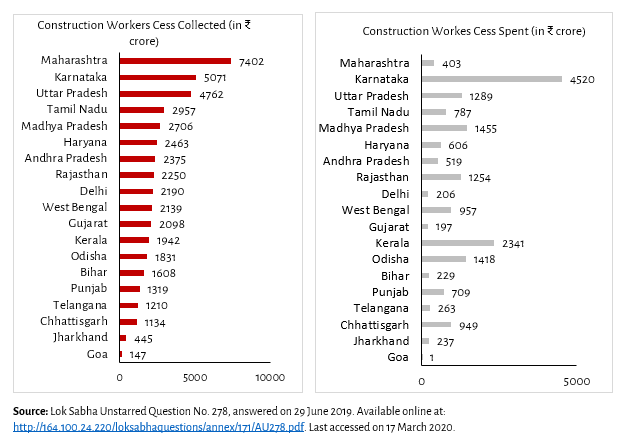
The welfare boards were established in states and UTs to regulate the conditions of construction workers under the Building and Other Construction Workers (Regulation of Employment and Condition of Services) Act passed by the Parliament in 1996. They were supposed to regulate working hours, provide drinking water, crèches, first aid, canteens etc. and ensure safety and health measures. The Act was the result of a decade long struggle of workers between 1985 and 1996.
The Parliament also passed another legislation viz. the Building and other Construction Workers’ Welfare Cess Act, 1996, which empowered the states and local authorities to levy and collect cess on the construction costs incurred by employers, government, public and private companies. The rate of cess imposed was envisioned to be not more than 2%, and not less than 1%. This is the cess that is passed on to welfare boards.
With low fund utilisation, however, it is unlikely that welfare boards have been able to deliver the proposed benefits to construction workers. But the need for protection measures was immense even before the Coronavirus pandemic began.
As per the National Sample Survey Organisation (2016-17), there are an estimated 74 million construction workers across the country. They come from poor economic and social backgrounds, usually lack education and have poor vocational skills, if at all. Poverty, illiteracy and poor language skills often contribute to their weak bargaining power when it comes to employment. This is exacerbated by a general lack of awareness of their rights with respect to minimum wages, working conditions, social security benefits and government welfare schemes. They are majorly employed in constructing roads, highways, flyovers, metro rails, malls, residential housing, etc.
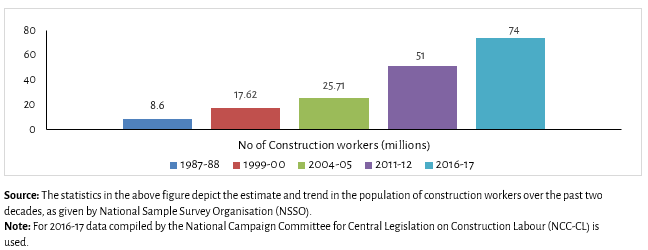
A new Labour Code on Social Security and Welfare by the Government of India is in the offing, and seeks to replace 15 laws on social security (including the BOCW Act). Many benefits presently accessible under the Act may not exist under the new code, and revoking it can have a catastrophic effect on construction workers as registrations of workers will lapse. There is already a huge gap between the estimated number of construction workers and registered workers with welfare boards (less than 50% of estimated workers are registered with such boards). Further down, it will also lead to the closure of 37 State and UTs BOCW boards and workers will have to again enrol themselves with the suggested state welfare boards. These newly formed state boards will also consist of other unorganised sector workers, and all of them will be listed in the same place. Moreover, the cess collected for the construction workers would go into a shared social assistance fund.
Thus, as the Coronavirus pandemic exposes construction workers to a difficult future, there is a need to reexamine what can be best done to secure them. This will require critical assessment of why less than half of the funds meant for their welfare have remained unspent in the first place.
References:
Katole H. (2016). A study of contract labour at a real estate and construction company. International Journal of Management. 7(3)
Moavenzadeh, F. (1978). Construction industry in developing countries. World Development, 6(1), 97- 116.
Mahajan, K. (2018). Rural Construction Employment Boom during 2000-12.
Prasad, R. S., Rao, K. V., & Nagesha, H. N. (2011). Study on building and other construction workers welfare schemes/amenities in Karnataka. SASTech-Technical Journal of RUAS, 10(1), 59-66.
Sharad is a Research Associate at Accountability Initiative.
Editorial inputs by Avantika Shrivastava
Indian Government’s COVID-19 Relief Package: Highlights
The Union government has announced a relief package of Rs 1.7 lakh crore today to protect migrant workers, urban and rural poor, and frontline health workers from the onslaught of the coronavirus pandemic.
The move was made to address “the welfare concerns of the poor, and suffering workers, and those who need immediate help,” Finance Minister Nirmala Sitharaman said in a press briefing where the package was announced.
The highlights of the Prime Minister Gareeb Kalyan scheme are:
- Two set of measures linked to cash transfers (Direct Benefit Transfers) and food security.
- Medical insurance cover of Rs 50 lakh per person for doctors, ASHAs, sanitation workers, frontline health workers.
Rs 50 Lakhs Medical insurance cover to be provided as part of #PradhanMantriGareebKalyanYojana to the frontline warriors- ASHA workers, Doctors, Nurses, Paramedics etc; @nsitharaman @FinMinIndia#IndiaFightsCorona #Lockdown21 pic.twitter.com/0rziELvJsx
— PIB India ?? #StayHome #StaySafe (@PIB_India) March 26, 2020
- For MGNREGS workers
#PradhanMantriGareebKalyanYojana
Government announces a wage increase in MGNREGA; to result in addition income of ₹2000/worker; to benefit 5 crore families #IndiaFightsCorona #Lockdown21 pic.twitter.com/tfPULtKtSp— PIB India ?? #StayHome #StaySafe (@PIB_India) March 26, 2020
Download our latest brief on MGNREGS
- For Farmers
#PradhanMantriGareebKalyanYojana relief to #FARMERS:
An advance 1st installment of ₹2,000 to be released as part of PM Kisan Samman Nidhi Yojana; To benefit 8.69 crore farmers.#IndiaFightsCorona #Lockdown21 pic.twitter.com/UpaFKggaf2— PIB India ?? #StayHome #StaySafe (@PIB_India) March 26, 2020
Download details about PM KIsan SAmman Nidhi
- For women with Jan Dhan Yojana accounts, the measures are
#PradhanMantriGareebKalyanYojana #ReliefPackage to women #JanDhan account holders: an
ex gratia amount of ₹500/month for next 3 months; to benefit 20 crore women #IndiaFightsCorona #Lockdown21 pic.twitter.com/Dn4y8xNYQZ— PIB India ?? #StayHome #StaySafe (@PIB_India) March 26, 2020
- Three free cylinders will be provided to 8 crore beneficaries under the Ujjwala scheme.
Government to provide 3 free cooking gas cylinders for the next 3 months under the #Ujjwala Scheme; to benefit 8 crore BPL families. #PradhanMantriGareebKalyanYojana #ReliefPackage #IndiaFightsCorona #Lockdown21 pic.twitter.com/M4WEdscusN
— PIB India ?? #StayHome #StaySafe (@PIB_India) March 26, 2020
- Women Self-Help Groups will be provided collateral-free loans of upto Rs 20 lakh.
- Government of India will pay 24% contribution to the Employee Provident Fund for the next 3 months for all establishments which have upto 100 employees, and 90% of who earn less than Rs 15,000 per month as wage. For full details on other measures for the organised sector, click here.
कोरोना वायरस महामारी से बच्चों का बचाव
आज जिस तरह से कोरोना वायरस ने विकराल रूप लिया है, उससे समझ में आता है कि अब सरकार के लिए अस्पतालों में भौतिक संसाधनों की उपलब्धता सुनिश्चित करने के साथ-साथ लोगों को नियमित जागरूक करना अत्यंत आवश्यक है| लेकिन सवाल ये उठता है कि क्या हमारे देश का हर बच्चा वायरस का सामना करने के लिए स्वस्थ्य है?
स्वास्थ्य और परिवार कल्याण मंत्रालय, भारत सरकार की व्यापक राष्ट्रीय पोषण सर्वेक्षण 2016-18 की रिपोर्ट के अनुसार भारत के बच्चे पूरी तरह से स्वस्थ नहीं हैं| रिपोर्ट बताती है कि भारत में 0-4 वर्ष के औसतन 35 प्रतिशत बच्चे अपनी आयु के अनुरूप अविकसित हैं तथा बिहार, मध्य प्रदेश, राजस्थान और उत्तर प्रदेश सहित कई सबसे अधिक आबादी वाले राज्यों में यह औसत 37 प्रतिशत से 42 प्रतिशत है। रिपोर्ट के आंकड़े यह भी बताते हैं कि भारत में 0-4 वर्ष के औसतन 33 प्रतिशत बच्चे अपनी आयु की तुलना में कम वजन के हैं| 1-4 वर्ष के पूर्व-विद्यालयी 41 प्रतिशत बच्चे, 5-9 आयु वर्ग के 24 प्रतिशत, स्कूल जाने वाले तथा 10-19 आयु वर्ग के किशोर-किशोरियों में कई बीमारियाँ नियमित रूप से पाई जा रही हैं। इन्हीं वजह से अधिक मामलों में कुपोषण बाल-मृत्यु का एक महत्वपूर्ण कारण बनता है|
जाहिर तौर पर यदि भविष्य में आने वाली युवा पीढ़ी ही इस तरह से अस्वस्थ होगी तो वे किस तरह से बीमारियों से लड़ पाने में सक्षम हो पायेंगे? खानपान की खराब आदतें, जैसे आयरन व विटामिन-सी से भरपूर भोजन (फल व सब्जियां) न खाना, और स्वास्थ्य सेवाओं तक सीमित पहुंच, खून की कमी या एनीमिया के बड़े कारण हैं। किशोरियों में एनीमिया (40 प्रतिशत), उनके समकक्ष किशोरों में एनीमिया (18 प्रतिशत) की तुलना में अधिक देखने को मिला है| इससे, विशेष तौर पर इन आयु वर्ग की श्रेणियों में, अपनी आयु के अनुरूप विकसित न होने की स्थिति बनती है और उनकी रोग प्रतिरोधक शक्ति भी कम रहती है|
भारत सरकार के पोषण अभियान 2018-22 के महत्वाकांक्षी लक्ष्य हैं, जिनमें शामिल हैं – सालाना बच्चों में कुपोषण की समस्या (स्टंटिंग और ओवरवेट) कम हो और लो-बर्थ वेट, यानि जन्म के समय कम वजन की समस्या को भी सालाना 2 प्रतिशत तक कम किया जाए। इसके अलावा, सभी आयु वर्गों में एनीमिया को 3 प्रतिशत तक कम करना भी पोषण अभियान का मुख्य लक्ष्य है, जिसे भारत में पोषण के लिए व्यापक स्तर पर जन आंदोलन चलाकर हासिल किया जाएगा|
हालाँकि आज की स्थिति में पूरा देश लॉकडाउन पर है और पोषण की एहम सेवाएं प्रभावित हैं। जिस तरह से व्यापक राष्ट्रीय पोषण सर्वेक्षण 2016-18 रिपोर्ट में स्कूल जाने की आयु वाले बच्चों और किशोरों पर कुपोषण का खतरा बताया गया है तो ऐसे में स्पष्ट है कि हम कोरोना वायरस की समस्या को जितना समझ रहे है, ये उससे कई गुना बड़ी हो सकती है|
मौजूदा समय में जिस तरह से सरकार, मीडिया एवं अन्य संस्थाओं की तरफ से लोगों को स्वच्छता के प्रति संजीदा रहने, अपने हाथ-मुंह साफ़ रखने को लेकर नियमित हिदायतें दी जा रहीं हैं, उनका पालन किया जाना आवश्यक है| वैसे भी अक्सर नियमित हाथ धोने से कई तरह की बीमारियों से आसानी से बचा जा सकता है जैसे टाईफाईड, दस्त, निमोनिया, पीलिया, हैजा, आँख की बीमारी आदि|
उम्मीद की जा सकती है कि समाज के हर वर्ग द्वारा स्वच्छता के सभी आयामों को अपने दैनिक जीवन में अनिवार्य रूप से इस्तेमाल किया जायेगा तथा बच्चों को ये सब चीजें उनकी जीवन शैली में शामिल करने के लिए नियमित प्रेरित किया जायेगा, ताकि कई जानों को संक्रमण से बचाया जा सके|
भारत सरकार द्वारा दी गई सलाह के बारे में जानने के लिए यहाँ देखें|
पॉलिसी बझः कोरोनाव्हायरस-फोकस संस्करण
कल्याणकारी धोरणात जे घडत आहे त्या प्रत्येक पंधरवड्यात प्रकाशित झालेल्या बातम्यांच्या निवडीसह अद्ययावत रहा. सध्याची आवृत्ती भारतातील कोरोनाव्हायरस (साथीचा रोग) सर्व देशभर (किंवा खंडभर) असलेला यावर लक्ष केंद्रित करते आणि सरकार वाढ थांबविण्यासाठी करत असलेले प्रयत्न.
धोरण बातमी
नोव्हेल कोरोनावायरस COVID-19
- पंतप्रधान नरेंद्र मोदी यांनी 19 मार्च रोजी COVID-19 च्या लढ्यावर राष्ट्राला संबोधित केले. या संकटाच्या वेळी त्यांनी नागरिकांची कर्तव्य विस्तृतपणे सांगितली. ते म्हणाले की, महामारीच्या परिणामापासून नागरिकांना वाचवण्यासाठी सरकार कित्येक उपाययोजना करणार आहे आणि त्यांनी आपल्या संबोधनात 9 कॉल-टू-एक्शन केले.
- अर्थमंत्री निर्मला सीतारमण यांच्या नेतृत्वात आर्थिक प्रतिसाद टास्क फोर्स जाहीर करण्यात आली आहे. हे (साथीचा रोग) सर्व देशभर (किंवा खंडभर) असलेला च्या आर्थिक परिणामांवर लक्ष देईल आणि पर्यटन आणि नागरी उड्डाण सारख्या क्षेत्रातील भागधारकांशी संपर्क साधेल.
- COVID-19 ही एक अधिसूचित आपत्ती घोषित केली गेली आहे, याचा अर्थ असा की महामारी आणि रोगाचा सामना करण्यासाठी केंद्र आणि राज्य सरकार अधिक निधी खर्च करण्यास सक्षम असतील. प्रत्येक राज्यातील आपत्ती व्यवस्थापन निधी (SDRF) चे पैसे तात्पुरते निवास आणि रुग्णांच्या आणि संशयित रुग्णांसाठी अन्न, पाणी आणि वैद्यकीय सेवा पुरवण्यासाठी वापरला जाईल.
- वेगवेगळ्या राज्य सरकारांनी (साथीचा रोग) सर्व देशभर (किंवा खंडभर) असलेला आणि त्याच्या निकालाच्या पार्श्वभूमीवर उपाययोजनांची घोषणा केली आहे. केरळने 20,000 कोटीच्या रुपये पॅकेजची घोषणा केली असून त्यापैकी 2,000 कोटी रुपये ग्रामीण रोजगार आणि या महिन्यात 100 कोटींचा मोफत रेशनसाठी वापर केला जाईल. उत्तर प्रदेश सरकारने रोजगाराच्या रूपाने 35 लाखां वेतन कामगारांना आणि बांधकाम कामगार 1,000 रूपये देण्याचे आश्वासन दिले आहे.
- संशयास्पद घटना त्यांच्या स्टॅम्प आणि मोबाईल फोनद्वारे द्वारे ट्रॅक केल्या जात आहेत.
- लोकसभेत COVID-19 च्या उद्रेकाशी संबंधित विविध विषयांवर चर्चा झाली. यात भारतीय नागरिकांची
स्थिती, विशेषत: परदेशात अडकलेल्या विद्यार्थ्यांची स्थिती, स्क्रीनिंग सुविधा, ईशान्येकडील नागरिकांची
वांशिक प्रोफाइलिंग यांचा समावेश आहे.
आरोग्य आणि पोषण
- राष्ट्रीय आरोग्य प्राधिकरण कडून समुदाय पातळीवरील प्रसारासाठी आयुष्मान भारत-PMJAY योजनेंतर्गत COVID-19 विशेष कार्यक्रमासाठी पॅकेज तयार करीत आहे.
- साथीचा रोग सर्व देशभर असलेला आजार लक्षात घेता सर्वोच्च न्यायालयाने राज्य व केंद्रशासित प्रदेशांना शाळांमधील विद्यार्थ्यांसाठी मिड-डे मटेरियल सेवा आणि गर्भवती व स्तनपान करणार्या महिलांसाठी अंगणवाड्यांमध्ये पौष्टिक जेवणाच्या नोटिसा बजावल्या आहेत.
- आंगनवाडी केंद्रे बंद पडल्यानंतर दिल्ली, कर्नाटक, केरळ आणि ओडिसामधील अंगणवाडी सेविका लाभार्थ्यांना भोजन पुरवित आहेत. एकट्या कर्नाटकातच या निर्णयाचा परिणाम 35 लाख मुलांवर होणार
आहे.
शिक्षण
- मानव संसाधन विकास विषयक संसदीय स्थायी समितीने मार्चच्या सुरूवातीस राज्यसभेत अहवाल सादर केला. या अहवालात असे दिसून आले आहे की देशातील जवळजवळ 40 % शाळांमध्ये वीज आणी खेळाची मैदाने नाहीत. यामध्ये अर्थसंकल्पात कपात आणि निधीचा कमी वापर यासारख्या शालेय प्रणालीला तोंड देणार्या इतर अडथळ्यांचा तपशील आहे.
- त्रिपुरा मधे जवळ-जवळ 5,000 आंदोलनकारी शिक्षकांना पोलिसांनी कलम 144 CrPC उल्लंघन केल्याबद्दल ताब्यात घेतले. जे राज्यातील पश्चिम जिल्हा प्रशासनाने कोरोनायरसचा प्रसार रोखण्यासाठी लागु केला होता.
Policy Buzz: Coronavirus-focus Edition
Keep up-to-date with all that is happening in welfare policy with this curated selection of news, published every fortnight. The current edition focusses on the Coronavirus pandemic in India, and the government’s efforts to stem its increase.
Policy News
COVID-19 Novel Coronavirus
- Prime Minister Narendra Modi addressed the nation on 19th March on combating the COVID-19. He elaborated on the duties of citizens during this crisis. He also said that the government will be undertaking a slew of measures to protect citizens from the impact of the pandemic, and made 9 calls-to-action in his address.
- An Economic Response Task Force under Finance Minister Nirmala Sitharaman has been announced. It will look into the economic repercussions of the pandemic, and will be in touch with stakeholders of sectors such as tourism and civil aviation.
- COVID-19 has been declared a Notified Disaster, which would mean that the Union and state governments will be able to spend more funds in order to tackle the pandemic. Money from each state’s Disaster Response Fund (SDRF) will be used for temporary accommodation and supply of food, water and medical care for patients and suspected patients quarantined.
- Various state governments have announced measures to tide through the pandemic and its fallout. Kerala has announced a Rs. 20,000 crore package, out of which Rs. 2,000 crore will be used for rural jobs and Rs. 100 crore will be used for free ration this month. The Uttar Pradesh government has promised Rs. 1,000 to more than 35 lakh daily wage and construction workers as sustenance money.
- Suspected cases are being handstamped and tracked via their mobile phones.
- The Lok Sabha has discussed various issues pertaining to the outbreak of COVID-19. These include the status of Indians citizens, especially students who are stuck abroad, screening facilities, racial profiling of citizens from the Northeast.
Health and Nutrition
- The National Health Authority is preparing a COVID-19 special package under the Ayushman Bharat- PMJAY scheme in the event of community-level spread.
- In view of the pandemic, the Supreme Court has issued suo motu notices to state and Union Territories on protecting the mid-day meal services for students in schools, and nutritious meals in Anganwadis for pregnant and lactating women.
- Anganwadi workers in Delhi, Karnataka, Kerala and Odisha have been delivering food to beneficaries following the closure of centres. In Karnataka alone, the decision will impact 35 lakh children.
Education
- The Parliamentary Standing Committee on Human Resource Development submitted a report to the Rajya Sabha in early March, which found that around 40% of government schools in the country don’t have electricity or playgrounds. It detailed other bottlenecks facing the schooling system like budget cuts and low utilisation of funds.
- Nearly 5,000 agitating teachers in Tripura were detained by the police for violating Section 144 CrPC, put in place by the West district administration in the state to curb the spread of coronavirus.
Gender Budgeting
- The money spent on women’s welfare schemes has remained stagnant over the years. Introduced in FY06, 4.8% of the total spending was allocated for women related schemes, which rose to 5.5% in FY09. However, it has stagnated since.
CPR Dialogues 2020- Tracking Government Spending: Challenges in Social Policy Financing
Watch the full video (above) of the panel discussion on ‘Tracking Government Spending: Challenges in Social Policy Financing’ featuring Rathin Roy (Director, National Institute of Public Finance and Policy); Alok Kumar (Adviser, NITI Aayog); Jeffrey Hammer (Senior Visiting Fellow, CPR); TR Raghunandan (Adviser, Accountability Initiative & Former Indian Administrative Service Officer) and moderated by Avani Kapur (Fellow & Director, Accountability Initiative, CPR). The panel marked the completion of ten years of the Accountability Initiative at CPR since it’s founding.
Despite significant investments in social welfare programmes, it is widely acknowledged that implementation is India’s Achilles heel and public service delivery is often plagued by inadequate quality, corruption and accountability failures. Yet, a discussion on the links between design and implementation is often constrained by the lack of evidence on the processes through which policies are translated on the ground.
What are the emerging trends of social policy financing in India? What should be the role of the Union Government in social policy financing in an era of more cooperative federalism? What is the role of technology in enabling a more efficient public finance management system? What is the optimal allocation of functions and capacities required across all levels of government to ensure an outcome-focussed financing system? By placing the current evidence on the processes involved in the delivery of social policies at the front and centre, this session aimed to revisit the current design of social policy financing given the recent changes in India’s fiscal architecture.
The panel was organised as part of the second edition of CPR Dialogues, held on 2nd and 3rd March 2020 at the India Habitat Centre. Addressing the theme of Policy Perspectives for 21st-century India, CPR Dialogues 2020 provided a window to the India of the future. Experts from around the country and the world engaged with and debated these very significant development and policy challenges that India faces in the coming decade.
ThePrint India was the digital partner for the event.
Media coverage of the session can be found below:
What India’s Crime Statistics on Violence Against Women Reveal
This blog is part of a series on crimes against women, and current legal and administrative safeguards. The first blog can be found here.
In my last blog I had highlighted the different kinds of crimes against women and the fact that these crimes are interrelated. The main question is whether the solutions to rape can be found in an isolated fashion, without considering the best way to tackle other interrelated crimes that were described in the previous blog. To address this question, one needs to look at the patterns in the numbers of crimes reported and the action taken on them.
Undertaking an analysis of the crime statistics is a tedious task. As related in last week’s blog, there are a bewildering array of crimes against women under several separate legislations. Though many of these are interrelated, the effort to bunch them together on the basis of their similarity is not undertaken in detail. Instead, in most cases, the data is presented for each piece of legislation, even though the crime concerned is similar to another, which is classified under a separate law.
In order to overcome these impediments, I undertook a classification on the basis of the nature of the crimes reported and came up with seven categories of crimes against women, and related crimes against children. Each category in turn comprises several different crimes, which may or may not be treated under the same law.
I formed seven categories of crimes against women as follows (Table 1):
| Cruelty within the family including dowry related cases and causing miscarriage, and abetting suicide | Dowry Prohibition Act, 1961 |
| Dowry Deaths (Sec. 304B IPC) | |
| Protection of Women from Domestic Violence Act | |
| Cruelty by Husband or his relatives (Sec. 498 A IPC) | |
| Abetment to Suicide of Women (Sec. 305/306 IPC) | |
| Miscarriage (Sec. 313 & 314 IPC) | |
| Rape and rape-related cases | Murder with Rape/Gangrape |
| Rape of Women (18 yrs and above) | |
| Rape of Girls (Below 18 yrs) | |
| Attempt to rape Women (18 yrs and above) | |
| Attempt to rape Girls (Below 18 yrs) | |
| Child Rape (Sec. 4 & 6 of POCSO Act) / Sec. 376 IPC) | |
| Sexual Assault of Children (Sec. 8 & 10 of POCSO Act) / Sec. 354 IPC) | |
| Trafficking | Human Trafficking (Sec. 370 & 370A IPC) |
| Procuring, inducing Children for the sake of prostitution (Section 5) | |
| Detaining a person in premises where prostitution is carried on (Section 6) | |
| Prostitution in or in the vicinity of public places (Section 7) | |
| Seducing or soliciting for purpose of prostitution (Section 8) | |
| Other Sections under ITP Act | |
| Selling of Minor Girls (Sec. 372 IPC) | |
| Buying of Minor Girls (Sec. 373 IPC) | |
| Sexual Harassment (Sec. 12 of POCSO Act) / Sec. 509 IPC) | |
| Use of Child for Pornography/Storing Child Pornography Material (Sec. 14 & 15 of POCSO Act) | |
| Assaults and insults to the modesty of women | Assault on Women with Intent to Outrage her Modesty (Total) |
| Insult to the Modesty of Women (Total) | |
| Acid attacks | Acid Attack (Sec. 326A IPC) |
| Attempt to Acid Attack (Sec. 326B IPC) | |
| Other offences against children | POCSO Act (Sections 17 to 22) / Other offences of POCSO Act |
| POCSO Act r/w Section 377 IPC / Unnatural Offences | |
| Cyber crimes and indecent representation of women | Publishing or Transmitting of Sexually Explicit Material [Sec. 67A/67B (Girls) IT Act] |
| Other Women-centric Cyber Crimes (Ex. Blackmailing/ Defamation/Morphing/Fake Profile) | |
| Indecent Representation of Women (Prohibition) Act, 1986 |
Using this categorisation, a study of the patterns of crimes against women became readily apparent, as detailed in Table 2.
Table 2: (Please note: Table numbers refer to the tables contained in the crimes statistics)
| Category of crime | Cases reported | No. of victims | Crime rate | Percentage of cases reported |
| Cruelty within the family including dowry related cases, dowry deaths, causing miscarriage, domestic violence and abetment to suicide | 1,28,370 | 1,32,045 | 21.93 | 35.67 |
| Assaults and insults to the modesty of women | 93,452 | 95,576 | 15.87 | 25.97 |
| Kidnapping and abduction of women | 66,333 | 68,735 | 11.42 | 18.43 |
| Rape, gangrape, attempts to rape and rape of children | 66,217 | 68,078 | 11.31 | 18.40 |
| Trafficking | 3,906 | 5,123 | 0.85 | 1.09 |
| Other offences against children | 763 | 772 | 0.13 | 0.21 |
| Cyber crimes and indecent representation against women | 625 | 640 | 0.11 | 0.17 |
| Acid attacks | 183 | 183 | 0.03 | 0.05 |
| Total | 3,59,849 | 3,71,152 | 61.64 |
When related crimes are put together, the real dimension of the problem of rape stands out. According to the NCRB report, rape crimes account for only 7 percent of all crimes against women However, the moment that rape related crimes are taken together, such as gang rapes, rapes of children, that are prosecuted under the POCSO act, and attempts to rape are added, 18 percent of all crimes against women fall into this category.
A further break up of all cases that fall within the ‘rape related’ category that I had put together, reveals the following pattern. (Table 3)
| Category of crime | Cases reported | No. of victims | Crime rate | Percentage of cases reported |
| Rape of Women (18 yrs and above) | 22,500 | 23,437 | 3.9 | 33.98 |
| Child Rape (Sec. 4 & 6 of POCSO Act) / Sec. 376 IPC) | 17,382 | 17,597 | 2.9 | 26.25 |
| Sexual Assault of Children (Sec. 8 & 10 of POCSO Act) / Sec. 354 IPC) | 11,899 | 12,224 | 2.0 | 17.97 |
| Rape of Girls (Below 18 yrs) | 10,059 | 10,221 | 1.7 | 15.19 |
| Attempt to rape Women (18 yrs and above) | 3,697 | 3,907 | 0.6 | 5.58 |
| Attempt to rape Girls (Below 18 yrs) | 457 | 465 | 0.1 | 0.69 |
| Murder with Rape/Gangrape | 223 | 227 | 0 | 0.34 |
| Total | 66,217 | 68,078 |
While rape of women above 18-years-old constitutes nearly 34 per cent of the cases reported, rapes of minors and children constitute 59.5 per cent of all cases. Clearly, children and minor girls are very vulnerable and are victimized.
What emerges is the clear pattern of most crimes against women arising from the domination of men over women. Rape is the most heinous form of such domination, but the stage is set through cruelty, often at home, assaults, abduction and trafficking. Rape does not occur in isolation of these, and the numbers of rapes are significant, even though it is not readily apparent from the crime statistics.


